
|   |

|   |
Saroja Mohanam: A son's tribute to a legendary dance couple - Shveta Arora e-mail: arorashveta1806@gmail.com Photos: Anoop Arora November 14, 2022 The sky is full of distant stars shining bright, but at times, the stars descend on you. It was an event of that magnitude when the stars shone in Delhi at IHC. The entire galaxy was shining bright and it was a moment to appreciate one's good fortune. This is an attempt to report parts of the event. 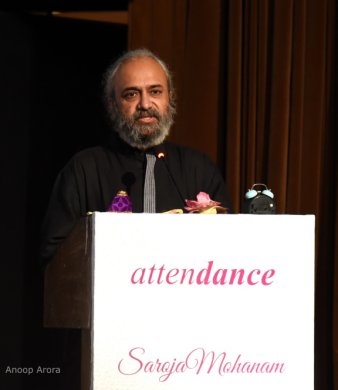 Ashish Mohan Khokar 'Saroja Mohanam' was hosted by Ashish Mohan Khokar as a tribute to his parents, Guru M.K. Saroja and Prof. Mohan Khokar, two of the luminaries of the world of Indian classical dance. The two-day event also included the launch of his dance annual, attenDance, for 2022. On the first day, the theme for the evening was Mystics in Dance. After the Saraswati Vandana by Pt. Kailash Sharma, a film about attenDance was screened where luminaries of Indian classical dance, present and past, were shown speaking about the book. It was a pleasant experience to watch gurus who have recently passed away, and others who were looking much younger than they are today. The guest editor for the book was Ranee Kumar. The first performer for the evening was Kavita Dwibedi, performing in Odissi. Her father, Guru Harekrishna Behera, and Mohan Khokar had had a long friendship. The stage had two brass urns with lotuses in them and a podium for the speakers. Kavita looked picture-perfect in her Odissi aharyam - a white Odiya sari with a red border. For her first piece, she chose a composition by Bhima Bhoi, who was a Kondh poet and a mystic who believed strongly in surrender. It was sung by Aakhya Mohanty. Here, the bhakta says that the only refuge from his destiny is the guru's lotus feet. The lyrics say 'Guru pada vrinda samarpan' or surrender to the guru's feet. And this would include not just oneself but also dhan dara sut (wealth, wife and children) and sansaar (world). The storms in the bhakta's destiny can only be quietened through surrender. And that surrender would bring the bhakta all that they wish for. Kavita, showed all her devotion towards her art and her guru in the piece. 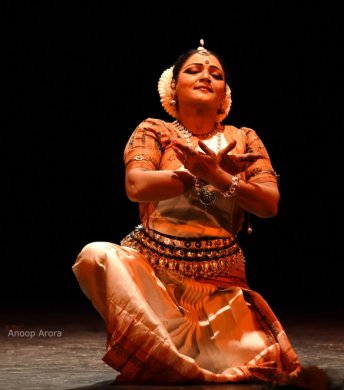 Kavita Dwibedi The second piece was a composition by Sant Meerabai. The music was by Suresh Sethi. Kavita said she chose the piece because she thought that if Mohan ji was Krishna, Saroja ji was Meerabai. The piece was "Jhuki aayi badariya saawan ki" (the lowering rainclouds arrive). Kavita has a very subtle style of dancing. Her moves are smooth and her nritya is expressive. The music and vocals were very evocative, as were the lyrics. Kavita began by showing the beauty of the season as Krishna is approaching. Prakriti waits for him to come. Meera is looking at the clouds, the lotuses blooming in the Yamuna and the peacocks dancing. As the clouds start to pour, lightning strikes. Krishna plays on his flute. As she hears him approaching, she waits in a trance. As a peacock, Kavita danced around the stage looking for Krishna to offer him his feather. The mayura spreads its wings, drops a feather and offers it to Krishna as he appears. As the rain falls, a mild wind blows - "Anand mangal bhaavan ki" (that which provides bliss, auspiciousness and delight). Meera welcomes her lord and offers the lotus of her heart at his feet. Kavita's abhinaya was very refreshing and subtle. The bhakta's longing and pleasure for the union with the lord was expressed well. The ambience of nature in monsoon which engenders love was well depicted. Her nritta, hastas and footwork were all very subtle and gentle. The peacock dance was pleasurable. Her mastery over her technique is remarkable. 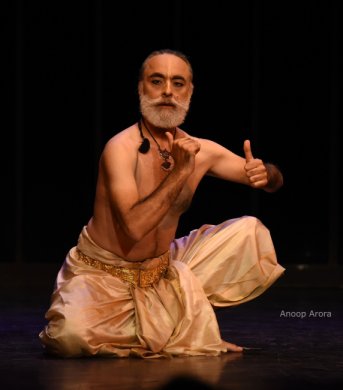 Navtej Johar The second performer for the evening was Bharatanatyam exponent Navtej Johar. In keeping with the theme for the evening, dance and mysticism, he performed a padam. This is a composition of the Tanjore Quartet, "Rama Rama prana sakhi" in raag Bhairavi, sung by Balakrishna Raghavan. Here, the protagonist is Krishna, who in a moment of despair in separation from Radha, asks Rama how he bore the separation from Sita when she was abducted and held captive by Ravana. Navtej is flawless in his abhinaya, which he renders with great ease. His productions are usually thematic, wherein nritta and nritya go hand in hand. This particular instance on which this padam is based, as described by Tulsidas in Manas, is loaded with emotions and anguish. It can be so deceptive that even Goddess Parvati mistook Rama to be a human in the pain of separation. So the piece was very apt for the evening and Navtej Johar. He wore a cotton off-white dhoti with a golden belt. Krishna, the lotus-eyed one, asks Rama, how did you go about the days of pain when your heart lay in smithereens, totally broken? Krishna, while herding his cows and playing the flute, is feeling the pangs of separation. He is told by Rama, who is describing his emotions to him, that he could not bear to live without setting his eyes on his moon-faced beloved. Navtej enacted the piece seated. Rama further tells Krishna that the lotuses of his eyes have wilted from shedding tears in separation. And you really could see big tears rolling down Navtej's cheeks. The viraha or pangs of separation are biting him like a snake. And then Rama remembers the time he had spent with Sita. He would comb her hair and tie them up in a bun. Her scent intoxicated him; and then again, he shudders with pain. The cooing of the birds that are playing with their mates is like needles to his ears. That cooing is like an arrow that is hurting him like arrows in his heart. He shoos the birds away and asks them to go elsewhere as the pain is burning him like flames in his being. Time has stopped for him. He misses rocking and kissing her and he tells Krishna that the lotus of his heart has wilted and been plucked and scattered around. He calls out to her as prana sakhi, the one dearest to his heart, and then Navtej rubbed his hands on his heart to show the roiling of emotions that Rama is experiencing. This was a very slow-paced piece which he performed mostly seated and totally based on his expressions to show the viraha (pain of separation) of Rama. He was so successful that it was not only his eyes which were moist - even I found my cheeks wet. It was performed with a great intensity of emotions and in the middle of it, the falling of his golden belt added to the intensity. 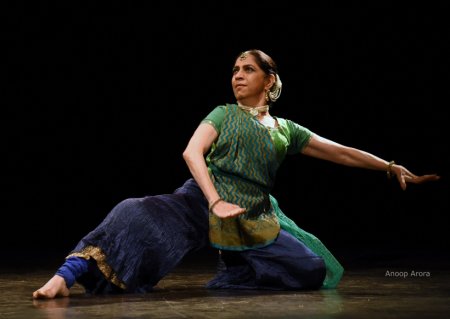 Aditi Mangaldas The third performer, Kathak exponent Aditi Mangaldas, wore a dress which was green and black-blue. Aditi is known not only for her interpretation of her dance form but also for her interpretation of the poetry. Here, she chose to perform to the Kabir poem 'Jhini Re Jhini'. For the piece, her depiction was of life being ephemeral, whether big or small. The Almighty created this life, which is very beautiful, but is impermanent, like a thin veil or a chadar. She started her performance sitting in the dark on the stage, her hands stretched upwards. While the flute played, Faraz Ahmed began with an alaap of 'Maula' as Aditi sat in her robe-like costume. The alaap was intensified by the flute and playing of the bells. The stage became a spiritually charged space. Aditi, as her foot was tapping to create the soft sound of the ghungroos, kept rubbing her fingers on each other to show how flimsy the chadar or the cloth of life is. As she kept emphasizing the concept of life being flimsy by rubbing her fingers together, she went on to depict the cloth being adorned by flowers, showing how beautiful this creation is. The Almighty gave a pulse and a heartbeat to this creation and infused it with life. But the lotus, though very pretty as it blooms and flowers, wilts away and the petals get scattered. You look aghast at the petals and try to gather them. The birds frolic, coo and then sadly, they die and their feathers get scattered. Aditi showed the anguish and the pain as she collects the feathers. All creation is turned to ashes as it ends. The bee comes to the flowers and hovers to sip the nectar as it flits on the flowers. The very beautiful butterfly comes in flying and yet all this is not here to stay. The elephant is huge and gigantic. Aditi depicted it through various gestures for its ears and its trunk. A peacock spreads its wings in pleasure. The lion, the king of the jungle, hunts down a sprightly deer. But all this is not permanent. The fabric of this life gets worn out day by day. It is flimsy and frail, as the rubbing fingers show. The sun shines bright in the sky and its rays fall to the earth. The rays are like a thin fabric, like the fabric of life. Kaun taar se bini - what threads has the lord used to weave this fabric and how did he weave it? Aditi depicted this by replicating the weavers' actions on the loom. Life, after it takes birth, grows to its fullest and then becomes old and dies. The ultimate verse in the poetry says "Das Kabir ne aisi odhi, jyun ki tyun dhar deeni." Kabir Das says that this flimsy fabric of life he wore but always kept it safe from the materialistic abrasion of this world, and surrendered it to the lord unsullied, as he received it, which Aditi performed in a very intense way - how this surrendering of this chadar or cloth happened between the bhakta and the Almighty. It is a known fact that art is a medium for the artiste to connect with the super soul. Aditi's performance very clearly showed how the artiste connects with the Almighty. There was no nritta and only through her gestures, her face and her hands and eyes did she depict the entire piece, which was made magical with the vocals by Faraz Ahmed. In fact, every pore in her body was dancing and every expression showed a glow from within. The function can be viewed here 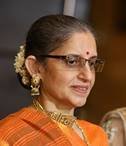 Shveta Arora is a dance-mad writer who chronicles classical dance events in Delhi. Ten years ago, she started the blog Kala Upasana at delhiculturecomment.blogspot.com, where she began posting her own writing along with photographs clicked by Anoop Arora, her husband. She's been dancing all her life as a devotee, but resumed her formal training in Kathak in her 50s and has passed her fourth year Kathak exams. |